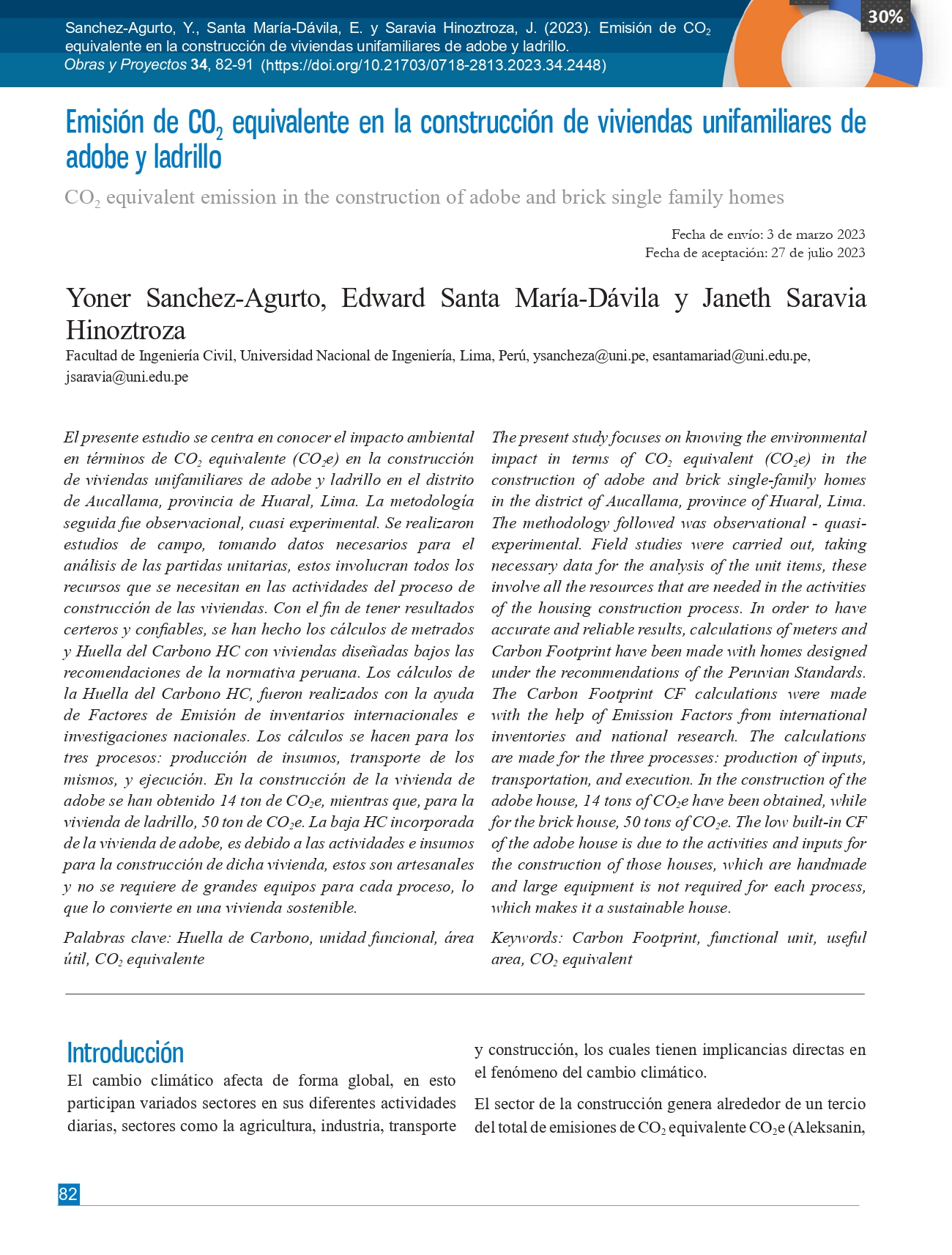Emisión de CO2 equivalente en la construcción de viviendas unifamiliares de adobe y ladrillo
DOI:
https://doi.org/10.21703/0718-2813.2023.34.2448Palabras clave:
Huella de Carbono, unidad funcional, área útil, CO2 equivalenteResumen
El presente estudio se centra en conocer el impacto ambiental en términos de CO2 equivalente (CO2e) en la construcción de viviendas unifamiliares de adobe y ladrillo en el distrito de Aucallama, provincia de Huaral, Lima. La metodología seguida fue observacional, cuasi experimental. Se realizaron estudios de campo, tomando datos necesarios para el análisis de las partidas unitarias, estos involucran todos los recursos que se necesitan en las actividades del proceso de construcción de las viviendas. Con el fin de tener resultados
certeros y confiables, se han hecho los cálculos de metrados y Huella del Carbono HC con viviendas diseñadas bajos las recomendaciones de la normativa peruana. Los cálculos de la Huella del Carbono HC, fueron realizados con la ayuda de Factores de Emisión de inventarios internacionales e investigaciones nacionales. Los cálculos se hacen para los tres procesos: producción de insumos, transporte de los
mismos, y ejecución. En la construcción de la vivienda de adobe se han obtenido 14 ton de CO2e, mientras que, para la vivienda de ladrillo, 50 ton de CO2e. La baja HC incorporada de la vivienda de adobe, es debido a las actividades e insumos para la construcción de dicha vivienda, estos son artesanales
y no se requiere de grandes equipos para cada proceso, lo que lo convierte en una vivienda sostenible.
Referencias
Aleksanin, A. (2019). Development of construction waste management. XXII International Scientific Conference on Construction for the Formation of Living Environment FORM2019, E3S Web of Conferences 97, 06040
Badilla, P., Elizondo, J.A., Fernández, T., Méndez, J., Mora F. y Quesada, M. (2015). CO2e: Cálculo de huella de carbono para materiales de construcción en Costa Rica. Seminario de graduación de Arquitectura, Universidad de Costa Rica, San José de Costa Rica
Balderas, H. y Arista, G.J. (2019). Análisis comparativos del ciclo de vida en procesos e insumos para construcción y vivienda. Seminario Internacional Hábitat Accesible, Universidad Autónoma de San Luis de Potosí, México
de Wolf, C., Yang, F., Cox, D., Charlson, A., Hattan, A.S. and Ochsendorf, J. (2016). Material quantities and embodied carbon dioxide in structures. Proceedings of the Institution of Civil Engineers- Engineering Sustainability 169(4), 150-161
Freire, A., Muñoz, J. y Marrero, M. (2016). Incorporación de huella de carbono y huella ecológica en las bases de costes de construcción. Estudio de caso de un proyecto de urbanización en Écija, España. Hábitat Sustentable 6(1), 7-17
Ghaffar, S.H., Burman, M. and Braimah, N. (2020). Pathways to circular construction: an integrated management of construction and demolition waste for resource recovery. Journal of Cleaner Production 244, 118710
IPCC (2014). Cambio climático 2014. Informe de síntesis. Grupo Intergubernamental de Expertos sobre el Cambio Climático, R.K. Pachauri y L.A. Meyer (eds.), Ginebra, Suiza
IPCC (2021). Directrices del IPCC de 2006 para los inventarios nacionales de gases de efecto invernadero. Vol.3, Procesos industriales y uso de productos. Intergovernmental Panel on Climate Change IPCC, Ginebra, Suiza
ISO 14040 (2006). Gestión ambiental — Análisis del ciclo de vida — Principios y marco de referencia. Ginebra, Suiza
León-Velez, A. y Guillén-Mena, V. (2020). Energía contenida y emisiones de CO2 en el proceso de fabricación del cemento en Ecuador. Ambiente Construido 20(3), 611-625
MAATE (2021). Norma técnica alcance a producto del programa Ecuador Carbono Cero. Ministerio del Ambiente, Agua y Transición Ecológica MAATE, Quito, Ecuador
MEM (2020). Uso eficiente de la energía. Guía metodológica para docentes del nivel inicial y primaria. Presentación Ministerio de Energía y Minas, Dirección General de Eficiencia Energética, Perú.
Mercader, M.P., Ramírez de Arellano, A. y Olivares, M. (2012). Modelo de cuantificación de las emisiones de CO2 producidas en edificación derivadas de los recursos materiales consumidos en su ejecución. Informes de la Construcción 64 (527), 401-414
Michell Torres, H. (2012). Perfil ambiental del acero. Universidad Industrial de Santander, Bucaramanga, Colombia

Descargas
Publicado
Número
Sección
Licencia

Esta obra está bajo una licencia internacional Creative Commons Atribución-NoComercial 4.0.







